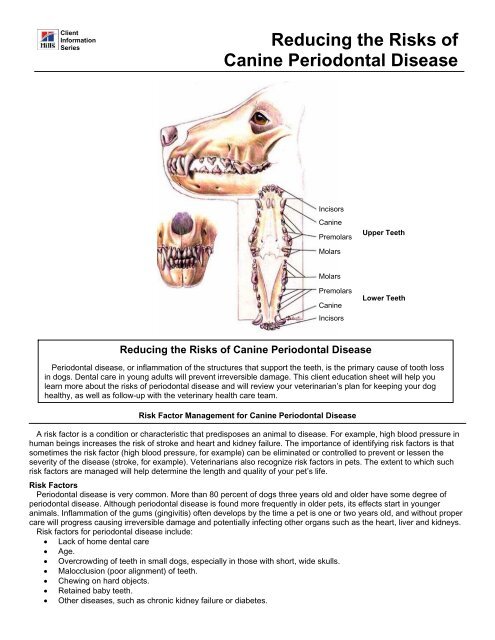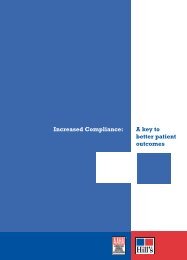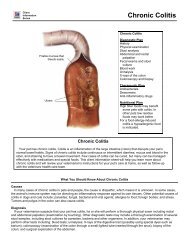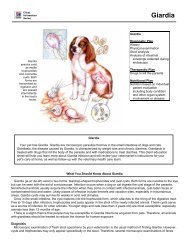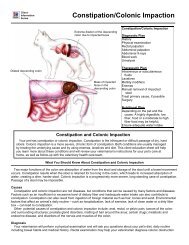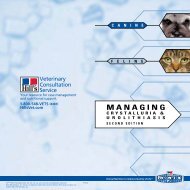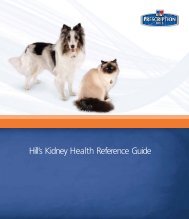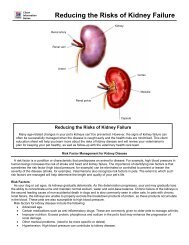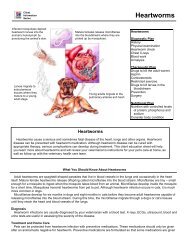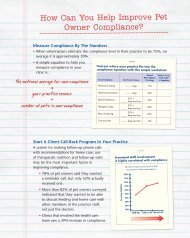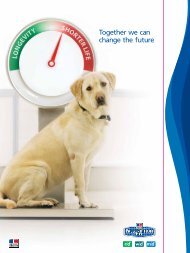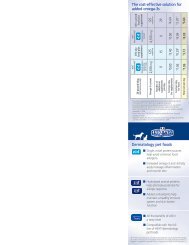Reducing the Risks of Canine Periodontal Disease - HillsVet
Reducing the Risks of Canine Periodontal Disease - HillsVet
Reducing the Risks of Canine Periodontal Disease - HillsVet
You also want an ePaper? Increase the reach of your titles
YUMPU automatically turns print PDFs into web optimized ePapers that Google loves.
Client<br />
Information<br />
Series<br />
<strong>Reducing</strong> <strong>the</strong> <strong>Risks</strong> <strong>of</strong><br />
<strong>Canine</strong> <strong>Periodontal</strong> <strong>Disease</strong><br />
Incisors<br />
<strong>Canine</strong><br />
Premolars<br />
Upper Teeth<br />
Molars<br />
Molars<br />
Premolars<br />
<strong>Canine</strong><br />
Incisors<br />
Lower Teeth<br />
<strong>Reducing</strong> <strong>the</strong> <strong>Risks</strong> <strong>of</strong> <strong>Canine</strong> <strong>Periodontal</strong> <strong>Disease</strong><br />
<strong>Periodontal</strong> disease, or inflammation <strong>of</strong> <strong>the</strong> structures that support <strong>the</strong> teeth, is <strong>the</strong> primary cause <strong>of</strong> tooth loss<br />
in dogs. Dental care in young adults will prevent irreversible damage. This client education sheet will help you<br />
learn more about <strong>the</strong> risks <strong>of</strong> periodontal disease and will review your veterinarian’s plan for keeping your dog<br />
healthy, as well as follow-up with <strong>the</strong> veterinary health care team.<br />
Risk Factor Management for <strong>Canine</strong> <strong>Periodontal</strong> <strong>Disease</strong><br />
A risk factor is a condition or characteristic that predisposes an animal to disease. For example, high blood pressure in<br />
human beings increases <strong>the</strong> risk <strong>of</strong> stroke and heart and kidney failure. The importance <strong>of</strong> identifying risk factors is that<br />
sometimes <strong>the</strong> risk factor (high blood pressure, for example) can be eliminated or controlled to prevent or lessen <strong>the</strong><br />
severity <strong>of</strong> <strong>the</strong> disease (stroke, for example). Veterinarians also recognize risk factors in pets. The extent to which such<br />
risk factors are managed will help determine <strong>the</strong> length and quality <strong>of</strong> your pet’s life.<br />
Risk Factors<br />
<strong>Periodontal</strong> disease is very common. More than 80 percent <strong>of</strong> dogs three years old and older have some degree <strong>of</strong><br />
periodontal disease. Although periodontal disease is found more frequently in older pets, its effects start in younger<br />
animals. Inflammation <strong>of</strong> <strong>the</strong> gums (gingivitis) <strong>of</strong>ten develops by <strong>the</strong> time a pet is one or two years old, and without proper<br />
care will progress causing irreversible damage and potentially infecting o<strong>the</strong>r organs such as <strong>the</strong> heart, liver and kidneys.<br />
Risk factors for periodontal disease include:<br />
• Lack <strong>of</strong> home dental care<br />
• Age.<br />
• Overcrowding <strong>of</strong> teeth in small dogs, especially in those with short, wide skulls.<br />
• Malocclusion (poor alignment) <strong>of</strong> teeth.<br />
• Chewing on hard objects.<br />
• Retained baby teeth.<br />
• O<strong>the</strong>r diseases, such as chronic kidney failure or diabetes.
Detecting Risk Factors<br />
Frequent and complete veterinary checkups are especially important as your pet ages. These checkups can help detect<br />
underlying causes <strong>of</strong> periodontal disease as well as <strong>the</strong> disease itself. These checkups are warranted once a year, or<br />
more frequently according to your pet’s oral health and your veterinarian’s instructions.<br />
Managing Risk Factors<br />
Your veterinarian will prescribe a routine periodontal management program for your dog. This program will eliminate or<br />
minimize as many risk factors as possible. A thorough pr<strong>of</strong>essional examination and dental cleaning that includes removal<br />
<strong>of</strong> plaque and calculus above and below <strong>the</strong> gum line will be provided by your veterinary health care team as <strong>the</strong> first step.<br />
Home care is <strong>the</strong> most important part <strong>of</strong> <strong>the</strong>rapy for preventing and managing periodontal disease. Frequent removal <strong>of</strong><br />
plaque from your dog’s teeth will help prevent periodontal disease and tooth loss. Plaque removal should begin in young<br />
animals because periodontal disease starts when pets are young.<br />
Your veterinarian will show you how to care for your pet’s teeth. The key to plaque removal is to make it a pleasant<br />
routine for your pet. Begin by handling your pet’s muzzle. (You can hold a small dog in your lap while you do this.) When<br />
your pet is comfortable with this, you can try to brush a small number <strong>of</strong> teeth, such as <strong>the</strong> incisor (front) teeth. When your<br />
pet accepts this, you can gradually work <strong>the</strong> brush around <strong>the</strong> sides <strong>of</strong> your pet’s mouth to reach <strong>the</strong> premolar and molar<br />
teeth. If your pet won’t tolerate a brush, you should try a s<strong>of</strong>t cloth. Your veterinarian has special toothpastes for your pet.<br />
Do not use human tooth paste on your pets.<br />
Your veterinarian will probably schedule routine <strong>of</strong>fice visits to check your pet’s teeth. These visits will allow him or her<br />
to help you combat periodontal disease through dental scalings and o<strong>the</strong>r necessary procedures designed to help your<br />
pet keep its teeth.<br />
Nutritional Plan<br />
If your pet has periodontal disease, your veterinarian may suggest a dietary change. Optimal nutrition provides for a<br />
pet’s need based on age and activity level, and reduces <strong>the</strong> health risks associated with feeding excess sodium, calcium,<br />
phosphorus, protein, and calories. Foods that avoid <strong>the</strong>se harmful excesses and also reduce <strong>the</strong> tartar and plaque that<br />
contribute to periodontal disease and bad breath include Hill’s® Prescription Diet® t/d® <strong>Canine</strong> Dental Health.<br />
Transitioning Food<br />
Unless recommended o<strong>the</strong>rwise by your veterinarian, gradually introduce any new food over a seven-day period. Mix<br />
<strong>the</strong> new food with your pet’s former food, gradually increasing its proportion until only <strong>the</strong> new food is fed.<br />
If your pet is one <strong>of</strong> <strong>the</strong> few that doesn’t readily accept a new food, try warming <strong>the</strong> canned food to body temperature,<br />
hand feeding for <strong>the</strong> first few days, or mixing <strong>the</strong> dry food with warm water (wait ten minutes before serving). Feed only<br />
<strong>the</strong> recommended food. Be patient but firm with your pet. This is important because <strong>the</strong> success or failure <strong>of</strong> treatment<br />
depends to a large degree on strict adherence to <strong>the</strong> new food.<br />
Presented as an educational service by<br />
Client’s Name:<br />
Patient’s Name:<br />
Medication(s):<br />
Home Care Instructions<br />
_________________________________________________________<br />
_________________________________________________________<br />
_________________________________________________________<br />
Nutritional Recommendation: ___________________________________________________<br />
Follow-Up Appointment: _______________________________________________________<br />
(Hospital Stamp Area Above)<br />
REGULAR VISITS WILL HELP OUR VETERINARY HEALTH CARE TEAM PROVIDE FOR YOUR PET’S BEST INTEREST.<br />
©2011 Hill’s Pet Nutrition, Inc.<br />
®/ Trademarks owned by Hill’s Pet Nutrition, Inc.


